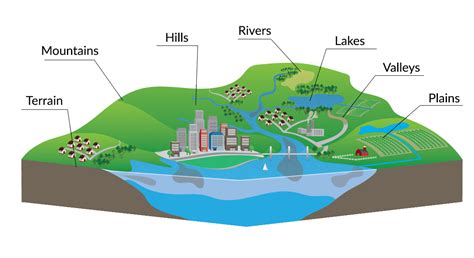Throughout history, humanity has been intertwined with the intricate tapestry of the Earth’s surface. From soaring mountains to meandering rivers, each geographical feature bears a profound significance that shapes our civilizations, economies, and cultural identities. Deciphering the meaning of these features unveils a hidden language that speaks volumes about our planet and our place within it.

Mountains: Sentinels of Elevation and Resilience
Mountains, towering giants of the landscape, symbolize strength, stability, and aspiration. They provide essential ecosystem services, such as watershed protection, biodiversity conservation, and climate regulation. According to the World Economic Forum, mountains cover 25% of the Earth’s surface and are home to 15% of the global population. However, they face significant challenges, including climate change impacts, deforestation, and infrastructure development.
Rivers: Arteries of Life and Commerce
Rivers, the lifeblood of continents, nurture ecosystems, connect communities, and facilitate trade and transportation. The Nile River, the world’s longest, has supported civilizations for thousands of years, providing water, food, and sustenance. The Amazon River, the largest in South America, is home to an estimated 10% of the world’s known species. Rivers are crucial for irrigation, hydropower generation, and tourism but also face threats from pollution, dam construction, and climate change.
Oceans: Vast and Enigmatic
Oceans, covering 71% of the Earth’s surface, remain largely unexplored and hold immense economic, scientific, and environmental value. They regulate global climate, provide food and energy resources, and support marine ecosystems. The United Nations estimates that the ocean economy generates approximately $3 trillion in annual revenue worldwide. However, oceans face pressing challenges, including overfishing, plastic pollution, and ocean acidification.
Forests: Lungs of the Planet
Forests, the Earth’s verdant lungs, play a vital role in carbon sequestration, oxygen production, and biodiversity conservation. The Amazon rainforest, the world’s largest, contains an estimated 10% of the world’s plant and animal species. Forests provide livelihoods for millions of people worldwide, offering timber, food, and medicinal resources. However, deforestation and forest degradation continue at alarming rates, threatening biodiversity and contributing to climate change.
Deserts: Arid Landscapes of Adaptation
Deserts, expansive and unforgiving, showcase the resilience of life in extreme environments. They cover approximately one-third of the Earth’s land surface and are home to a diverse array of plants and animals adapted to arid conditions. Deserts are important sources of minerals, fossil fuels, and renewable energy, but they also face challenges such as water scarcity, soil erosion, and climate change impacts.
Common Mistakes to Avoid
When interpreting geographical features, it is essential to avoid common mistakes that can lead to misunderstandings or inaccurate conclusions:
- Oversimplification: Geographical features are complex and multifaceted, and their meanings cannot be reduced to simplistic labels.
- Geographic determinism: The assumption that geographical factors alone dictate human behavior and development is simplistic and outdated.
- Ignoring human agency: Geographical features influence human societies, but humans also have the capacity to modify and adapt to their environment.
- Lack of perspective: Geographical features can have multiple meanings and perspectives, depending on the context and the observer.
Conclusion
Geographical features are not merely static elements on a map but living, breathing entities that shape our lives and our planet. By understanding their meanings, we can appreciate their profound implications on our societies, economies, and environments. As we navigate the challenges of the 21st century, an in-depth understanding of geographical features will prove invaluable in planning for sustainability, mitigating risks, and ensuring a harmonious coexistence between humanity and nature.
Applications and Further Research
The study of geographical features has numerous applications and opportunities for further research:
- Urban planning: Understanding the topography, hydrology, and vegetation of urban areas can inform sustainable development and enhance urban resilience.
- Climate change adaptation: Geographical features can provide insights into climate change impacts and vulnerabilities, enabling communities to develop adaptation strategies.
- Resource management: Analyzing the distribution and availability of resources, such as water, minerals, and energy, can support informed decision-making and sustainable exploitation.
- Cultural heritage preservation: Geographical features can be closely intertwined with cultural identities and traditions, highlighting the need for protection and preservation.
Further research in geographical features can explore emerging topics such as:
- Geoinformatics: The integration of geographical data with computer science techniques to analyze and visualize spatial relationships.
- Environmental modeling: The use of computer simulations to predict the impact of human activities on geographical features and the environment.
- Spatial economics: The study of how geographical factors affect economic activities and development.
By embracing the meaning of geographical features and fostering interdisciplinary collaboration, we can unlock a wealth of knowledge that will guide us towards a more sustainable and equitable future.
